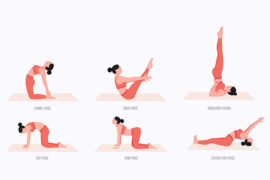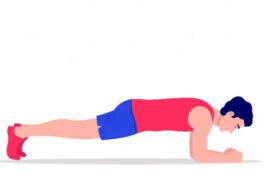The variability in calories burns during the same workout, evident in group fitness classes with displayed heart rates and estimated calories burns, raises the question of why individuals burn calories at such different rates. Notably, it’s observed that men generally burn more calories than women. The answer to this lies in several factors, including individual differences in body composition, metabolism, and fitness levels. Muscle mass, which tends to be higher in men, plays a crucial role as muscle tissue requires more energy than fat tissue. Metabolic rate, influenced by genetics and lifestyle, also varies among individuals. Fitness levels and workout intensity contribute to calories burn, with factors like age and hormonal differences further influencing the overall equation. In essence, the diverse interplay of these factors results in the distinct calories burns seen among individuals, even when engaging in the same exercise routine.
1. Fitness Level:
Engaging in a particular type of workout regularly leads to the body’s adaptation, making the exercise feel easier over time. This adaptation is not just a mental perception but a physical reality, as explained by Gonzalez. The positive aspect is that this adaptation allows for improved performance, such as running faster or lifting heavier weights, with consistent practice and proper training.
However, there’s a flip side to this adaptation—your body becomes more efficient, resulting in a reduced calories burn during the same workouts. Gonzalez highlights that this efficiency spans across various bodily systems, including the lungs, muscles, heart, and brain. Essentially, as you become more fit, your body expends fewer calories to perform the same exercises. This phenomenon explains why beginners might initially burn more calories than individuals who have been doing the same workout for an extended period.
To counteract this reduced calories burn and continue progressing in fitness, Gonzalez recommends changing your workout routine. Altering factors such as the time of day, the type of exercise, or the order of exercises introduces new challenges, preventing your body from fully adapting to a specific routine. This variation can contribute to an enhanced fitness level and potentially increase calories burn, providing a more well-rounded approach to physical conditioning.
2. Age:
As we age, a common phenomenon is the gradual loss of muscle mass. This process typically begins around the age of 30, and individuals may experience a decline of about 3 to 5 percent in muscle mass per decade. The exact reasons for this muscle loss are not completely understood, but it is thought to be linked to increased resistance to hormones that play a crucial role in promoting protein synthesis essential for muscle maintenance.
This reduction in muscle mass has significant implications for metabolism. Metabolic rate, which is the speed at which the body burns calories, both at rest and during exercise, tends to decrease with the loss of muscle mass. However, a 2021 study challenging this conventional belief made headlines by suggesting that metabolic rate may not consistently decline throughout adulthood. Instead, it proposed a plateau between the ages of 20 and 60, followed by a decline. Despite these findings, experts caution that this doesn’t necessarily mean everyone experiences a constant calorie burn throughout adulthood, as aging involves numerous physiological changes that may not have been fully accounted for in the study.
Although the aging process is inevitable, strategies such as regular strength training can play a crucial role in preserving or even increasing muscle mass. According to Gonzalez, engaging in strength training can elevate your resting metabolic rate, leading to more calories burned at rest over time. While aging brings about various physiological changes, maintaining muscle through exercise is a key approach to supporting overall health and metabolic function.
3. Muscle Mass:
The relationship between muscle mass and calories burn adds a nuanced layer to the fitness equation. Individuals with greater muscle mass tend to burn more calories than their counterparts who weigh the same but have less muscle. This is due to the fact that muscle tissue inherently requires more energy than fat tissue, as explained by Jenaed Brodell, a London-based sports nutritionist.
When it comes to exercise, having more muscle mass becomes particularly advantageous. This is because a higher muscle mass increases the overall calories burn during physical activity. As muscles contract at an elevated rate during exercise, the body needs to produce more energy to sustain this heightened muscular activity. In essence, if you’re aiming to enhance your calories burn, emphasizing strength training in your fitness regimen becomes a valuable strategy. Strength training not only contributes to building and maintaining muscle mass but also amplifies the calorie expenditure during both strength workouts and other forms of exercise.
4. Body Weight:
Body weight plays a crucial role in calorie expenditure during exercise, according to Kyle Gonzalez, the head of content for Momentus, a supplement company. Generally, individuals who weigh more burn more calories per session because moving a heavier body requires more energy. This simple relationship means that, all else being equal, a person with a higher weight will have a greater energy expenditure during physical activity.
Furthermore, individuals with larger bodies often have larger internal organs, including the heart, liver, kidneys, and lungs. The size of these organs significantly contributes to the overall calories burn, both during exercise and at rest, as these organs and their functions require energy. Research indicates that differences in internal organ size could explain up to 43 percent of the variation in total calorie burn between individuals.
Understanding the impact of body weight on calories burn is crucial in the context of weight loss. As individuals lose weight, their bodies tend to burn fewer calories, potentially leading to weight loss plateaus or even weight regain. This complexity is further compounded by hormonal changes that accompany weight loss, influencing hunger and satiety cues. To navigate these challenges, seeking guidance from a registered dietitian specializing in weight loss is recommended for a healthy and sustainable approach.
It’s essential to note that while exercise may not always lead to significant long-term weight loss, it offers numerous health benefits. A 2021 review highlighted that increased exercise is associated with improved cardiorespiratory fitness, leading to better overall health and a reduced risk of premature death, regardless of changes in weight. Therefore, focusing on the health benefits of exercise, in addition to weight-related goals, contributes to a holistic approach to well-being.
5. Training Intensity:
The calories burn during a workout can vary significantly between individuals, even if they appear to be doing the same exercise. Jenaed Brodell notes that the intensity of the workout plays a crucial role. Someone exercising at a high intensity, characterized by heavy breathing and the inability to carry on a conversation, can burn twice as many calories in the same duration as someone working out at a lower intensity. Simply covering the same distance or performing similar motions doesn’t necessarily mean both individuals are working out at the same intensity.
The Department of Health and Human Services (DHHS) emphasizes that walking and running offer similar health benefits, such as lowering blood pressure and reducing the risk of chronic conditions like heart disease and type 2 diabetes. However, a study found that running a mile burns more calories than walking the same distance, highlighting the impact of exercise intensity on calorie expenditure.
For overall health benefits, the DHHS recommends 150 minutes of moderate-intensity or 75 minutes of high-intensity exercise per week. This can lead to reduced anxiety, improved sleep, lower blood pressure, increased cardiovascular fitness, and a decreased risk or slowed progression of certain chronic conditions. To intensify workouts, the American Council on Exercise (ACE) suggests increasing speed, range of motion, or the weight used in strength-training exercises. Additionally, high-intensity interval training (HIIT) is recommended as an efficient way to boost workout intensity and calories burn. Incorporating these strategies into your fitness routine not only enhances calorie expenditure but also magnifies the overall health benefits of exercise.
Disclaimer:
The information contained in this article is for educational and informational purposes only and is not intended as a health advice. We would ask you to consult a qualified professional or medical expert to gain additional knowledge before you choose to consume any product or perform any exercise.









